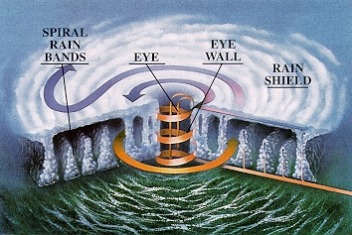Hurricane Formation
Hurricanes require a special set of conditions, including ample heat and moisture, that exist primarily over warm tropical oceans. For a hurricane to form, there must be a warm layer of water at the top of the sea with a surface temperature greater than 80 degrees F (26.5 degrees C). Warm seawater evaporates and is absorbed by the surrounding air. The warmer the ocean, the more water evaporates. The warm, moist air rises, lowering the atmospheric pressure of the air beneath. In the Southern Hemisphere, the winds rotate clockwise around a low. This effect of the rotating earth on wind flow is called the Coriolis effect. (This is why hurricanes look like a pin wheel from space) The Coriolis effect increases in intensity farther from the equator. For a hurricane to develop, there must be little wind shear -- that is, little difference in speed and direction between winds at upper and lower elevations. Uniform winds enable the warm inner core of the storm to stay intact. The storm would break up if the winds at higher elevations increased markedly in speed, changed direction, or both. The wind shear would disrupt the budding hurricane by tipping it over or by blowing the top of the storm in one direction while the bottom moved in another direction.
source: http://www.nasa.gov/worldbook/hurricane_worldbook.html
Parts of a hurricane

The rain shield is a solid or nearly solid area of rain that typically becomes heavier as one approaches the eye.
Spiral convective rings or bands are the regions of active showers and thunderstorms than encircle the centers of tropical cyclones.
The eye wall is an organized band of thunderstorms that immediately surrounds the center or eye of a hurricane. It's generally around 15 miles wide and typically contains the fiercest winds and most intense rainfall.
The eye is a relatively calm center of the hurricane. The average hurricane eye diameter is a little over 20 miles.
source: http://www.co.orange.tx.us/parts_of_hurricane.htm
Where hurricanes form
To produce a hurricane, a low-pressure area must be more than 5 degrees of latitude north or south of the equator. Hurricanes seldom occur closer to the equator. This means the Atlantic Ocean and the Gulf of Mexico are prime waters for hurricane formation.
source: http://www.nasa.gov/worldbook/hurricane_worldbook.html
Category Information
Developed in the early 1970s by Herbert Saffir, a consulting engineer, and Robert Simpson, then Director of the National Hurricane Center, it is a measure of hurricane intensity on a scale of 1 to 5. The scale categorizes potential damage based on barometric pressure, wind speeds, and surge.
source: http://www.weather.com/glossary/s.html?from=search_siteresults%3C1%3E
For a VERY cool graphic on the damage each different category can do to a house/building, click on this link from NASA.
